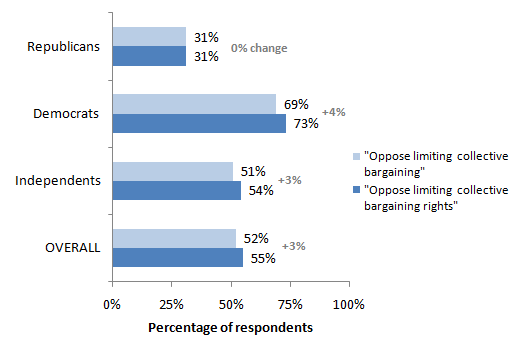Polling, communications strategy, and Ohio Senate Bill 5
Governmental entities, nonprofit agencies, or their private-sector communication partners often want to learn 1) the psychological “hot buttons” that may generate a desired response (e.g., “Give time/money!” “Vote yes on Issue X!”) and 2) the psychological “red flags” that may generate an undesired response.
We find this type of research fascinating and oddly exciting. However, confidentiality agreements limit our ability to talk about most of the work we’ve conducted in this capacity.
Just last week, however, we became aware of survey results from the independent Quinnipiac University Polling Institute regarding a highly contentious issue in Ohio: Senate Bill 5. These results have the potential to guide communications strategy, and because we are a neutral party to the issue*, we are able to comment on it.
For those who may be unaware, Senate Bill 5 calls for major changes to Ohio’s labor laws. As may be expected, the passage and eventual signing of Senate Bill 5 led to a strong outcry from those who are most likely to be negatively affected by the legislation, including state and municipal employees and teachers. Over the past few months, hundreds of thousands of Ohioans have signed a petition with the intent to repeal this law, with a major political fight brewing for November 2011.
In Quinnipiac’s poll of registered voters, we noticed there were two questions asked of respondents that demonstrates how research has the potential to affect communications strategy.
Half of the 1,600+ respondents were randomly selected to hear the following question:
As you may know, there is a new law in Ohio that would limit collective bargaining for public employees. Do you support or oppose limiting collective bargaining for public employees?
The other half of the respondents were asked a slight variation of the same question:
As you may know, there is a new law in Ohio that would limit collective bargaining rights for public employees. Do you support or oppose limiting collective bargaining rights for public employees? (emphasis added)
How much difference can one word make? As shown in the chart below, including the word “rights” leads to changes in the percent of individuals who say they oppose this law – changes that approach statistical significance (meaning the difference is unlikely to have been caused by chance alone). This effect is strongest among registered Democrats, most of whom report a desire to oppose the legislation.
Although this pattern is small, it shows how quality research has the potential to influence communications strategy. In other words, if these polling patterns remain stable or become stronger through the rest of the summer, I would expect those groups that oppose Senate Bill 5 (and who favor its repeal) to position the repeal issue in terms of worker rights that are threatened. Time will tell.
* The Strategy Team, Ltd. has not been retained by individuals or groups on either side of this issue. Like the majority of Ohioans, we’re interested observers.
How neighbors stay informed about community issues
I recently happened upon a public opinion poll from the Pew Research Center that explored a topic that I’ve been curious about for some time. In this age of Facebook, Twitter, blogs, text messaging, and e-mail, how are Americans staying informed about what’s going on in the world closest to them – their neighborhoods, their communities? To what extent has “tech” entered this arena, and to what extent are Americans staying abreast of events the old-fashioned way, by talking face-to-face?
According to those surveyed, at some point in 2009…
- 46% of Americans talked face-to-face with neighbors about community issues.
- 22% of Americans signed up to receive alerts about local issues (such as traffic, school events, weather warnings or crime alerts) via email or text messaging
- 21% of Americans discussed community issues over the telephone.
- 20% of Americans used digital tools to talk to their neighbors and keep informed about community issues.
- 11% of Americans read a blog dealing with community issues.
- 9% of Americans exchanged emails with neighbors about community issues and 5% say they belong to a community email listserv.
- 4% of Americans communicated with neighbors by text messaging on cell phones.
- 4% of Americans joined a social network site group (e.g., Facebook) connected to community issues.
- 2% of Americans followed neighbors using Twitter.
[Note: Emphasis added. Because survey participants could respond affirmatively to more than one option, the sum of percentages is > 100%.]
One of the take-away messages from this report is that while high-tech communication modes have a place in how Americans stay connected to one another and to their community, use of these modes does not (yet) surpass good ol’ fashioned discussions over the backyard fence or across porches. If one’s marketing objective is to mobilize grassroots support, to build local awareness of an issue, or to mobilize a community to action, these data seem to suggest the best kind of “word-of-mouth” tactic may be the original kind – by encouraging people to literally talk with one another.

[Survey methods note: The survey was conducted via telephone (either landline or cellphone) with a random sample of 2,258 American adults. The full report can be downloaded here.]
Research in action – projecting demand for a second campus
One of my favorite parts of applied research is… well… its application. Back in 2003, TST helped Columbus State Community College project demand for a second college campus and determine where said campus might be located. We used GIS mapping, surveys and focus groups with students and stakeholders as well as a RDD survey of the four county area surrounding Columbus to provide CSCC with the information they needed to make a good decision. TST documented and projected enrollment trends, created demographic and lifestyle profiles of current and potential future students and highlighted potential barriers and supporting factors that could impact demand for (and construction of) a second campus.
On June 28th, the ribbon cutting for the second campus (located very near one of the locations we suggested 7 years ago!) will take place. I’d like to think we helped provide the foundation for that building – pun intended.

